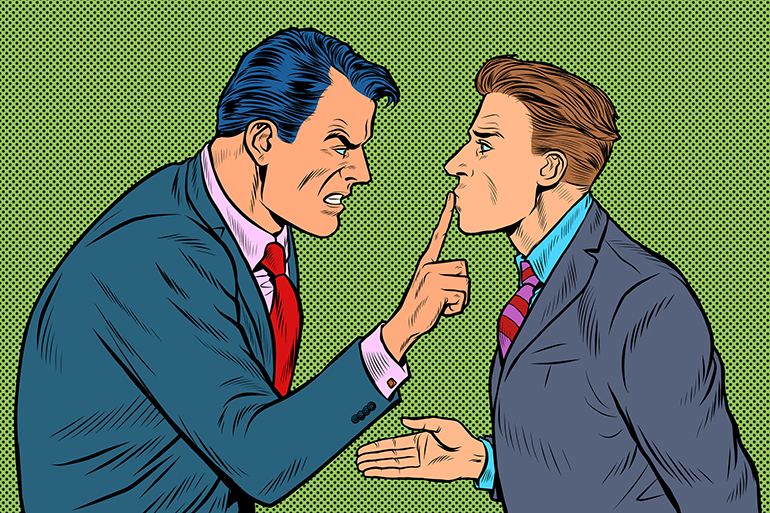
The anti-gun crowd would love you to believe that people who carry a firearm for personal defense are blood-thirsty killers, or people who just “wish a motherf-er would.” But, in the words of Harold Fish, a man who was run through the criminal justice meatgrinder in Arizona a few years ago, “It’s not the ultimate big game tag” to shoot a fellow human being.
The truth is that even a justified self-defense shooting can be a horrendous experience for all involved. It certainly beats the alternative (death or grievous bodily harm), but sometimes it doesn’t beat it by much. The direct trauma of the experience itself, the subsequent criminal investigation, the ordeal of a criminal trial, any possible civil lawsuits, and many other results that can and do go along with a defensive gun use are best avoided if at all possible.
I want to share a quick technique from George J. Thompson, PhD, the author of Verbal Judo: The Gentle Art of Persuasion. Verbal Judo is the gold standard in non-violent dispute resolution and is taught widely to law enforcement, military personnel, and people training with competent concealed carry instructors. It’s worth reading the book or watching some of the YouTube videos where Thompson explains the concept in greater depth.
One tool he teaches is known by the acronym LEAPS, which stands for Listen, Empathize, Ask Questions, Paraphrase, and Summarize. It’s not a checklist you have to work your way down, but it’s an easy way to remember these five important conversational tactics that can. be used under stress and then pick the tactic that best fits the situation you’re in. It’s best to think of LEAPS as a toolbox.
Listen
Often, an upset person who might get violent will calm down if they feel like you care how they feel. One great way to do this is by being an active listener. For this one, here’s another acronym (sorry!) I got from the Texas DPS that you can use to remember ways to be an effective active listener.
LISTENS:
- Look at them
- Interest: Show an interest in what they’re saying
- Summarize what was said, repeat it back for confirmation
- Territory: Give people some space
- Empathize with them
- Nod to show understanding (this doesn’t interrupt them, but signals that you’re hearing them out)
- Smile when appropriate (don’t smile at an angry person who might take it as an insult)
Empathize
Another way to break dangerous ice is to see where the other person is coming from, as twisted as their point of view may seem at the time. If they appear to be living in an alternate reality, use your imagination to join them in that reality. Common empathy blockers to avoid include:
- Moralistic judgments
- Making comparisons to your ideal self
- Denial of your own responsibility to communicate (“This person is NUTS!”)
Ask Questions
Asking questions is important for more than just letting them know you’re listening (and stringing the process out to let the other party calm down). If you can further understand what’s going on, you can better understand how to resolve the situation. So be sure to ask important details, like the “Five Ws” (Who, What, When, Where, Why). The last one (the “why”) is probably the most important.
Paraphrase, aka “Mirroring”
To use this conversational tactic/tool, put the person’s meaning into your own words and say it back to them for clarification and confirmation. If someone is being particularly irrational, at this point they might realize how crazy it sounds to hear it coming from somebody else’s mouth…and rethink their position. If they backpedal, resist the temptation to tell them, “I told you so!” because they may fight you just to save face.
Let them backpedal and change their mind, because that’s how you win.
Summarize
Sum up the situation and work with the person to fix the impasse now that you understand it. Re-clarify as needed to work out the rest of the problem. This is kind of like paraphrasing, but it’s a good way for you to let them know what the situation looks like to you.
If done calmly and politely, it gives them a chance to give their side of the story and helps them feel like you care.
The Most Important Thing
Empathy is the most important part of every tool in the LEAPS toolbox. Seeing things the way other people see them is the key to having any amount of power in communication. The moment you stop thinking like the other side, you’re done. It’s over. You’ve lost the plot.
It may feel good to hit people hard with insults or to say things like “I told you so!” or “Because I said so!” but it can lead to an escalation with someone who could have been talked down out of the tree.
Stay calm and stick with empathy whenever possible. If you find yourself getting angry or scared in a tense situation, remember LEAPS.
